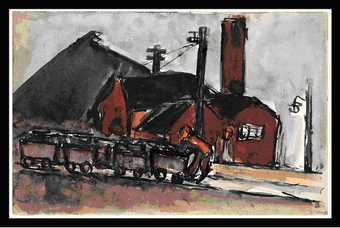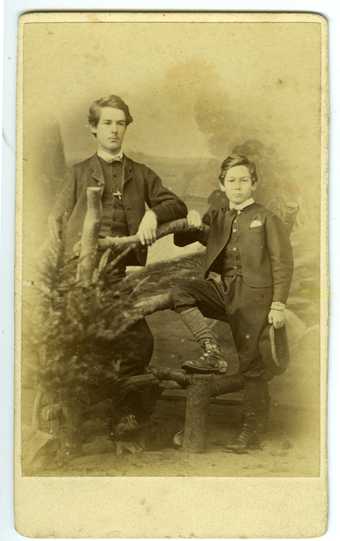
Josef HermanUntitled, coal trucks 1944-55 Ink, wash and watercolour sketchTGA 835/40The Estate of Josef Herman
Hello, I’m Adrian Glew and as Tate’s Archivist, it has been my great pleasure and privilege to select – with the invaluable input of my colleagues in the archives team, Allison Foster, Emily Down and John Langdon – 52,000 pieces from 52 diverse collections for digitisation in this project.
As Polly Christie touched upon in our very first blog, by selecting so many pieces we have endeavoured to tell the story of British art and its social context to a much wider group of people than currently accesses our resources. The project has an unprecedented UK-wide reach and relevance with at least three artists’ archives selected for each area of the country.
To give an idea of the collections chosen for Wales, for example, we will be digitising all forty of Graham Sutherland’s sketchbooks – including images in and around his home in Pembrokeshire – as well capturing all our sketches and drawings by David Jones, who was fascinated by his Welsh heritage, and finally, the complete holdings of Josef Herman’s artworks, notably his sensitive and heroic portrayals of miners and their families made during his extended eleven year’s stay in Ystrandglynlais, a small mining village in South Wales.
Other highlights that will be digitised over the coming months include the entire photographic archives of Eileen Agar, Paul Nash and John Piper. The latter collection includes many images of churches, stately homes and street scenes around the UK. As some of these images are currently unidentified, we’re hoping that lots of you will be able to identify as many images as possible through crowdsourcing – a great way for users to interact and collaborate with us to provide invaluable local information.
This film file is broken and is being removed. Sorry for any inconvenience this causes.
Archives & Access project: Animating the Archives – Eileen Agar, a British surrealist
Chronologically, we’ll be digitising a wide range of material from the late nineteenth century in the guise of artists connected to the Newlyn School such as Stanhope Forbes, Thomas Gotch and Henry Scott Tuke to more contemporary artists such as Ian Breakwell, Paul Neagu and Stuart Brisley.

Mounted photograph of Henry Scott Tuke as a boy (on right) and his elder brother William Samuel Tuke, c 1874 Photographer: W.H. Dunstan, Falmouth TGA 9019/1/4/2/4© The Estate of W. H. Dunstan
In addition to a wide regional relevance (from Welsh chapels to Newlyn fishing boats), digitised items will also illustrate significant themes represented in our archival collections such as the rural and urban landscape; sculptural practice; the émigré experience; and popular culture. We will also be tackling the under-representation of artists of colour, Ronald Moody, Aubrey Williams and Donald Rodney; women artists such as Barbara Hepworth, Ithell Colquhoun, and Felicia Browne (the first British woman to be killed in the Spanish Civil War) and the LGBT community represented by items relating to Francis Bacon, Prunella Clough, and Keith Vaughan.
Working with Tate Learning, we have also ensured that there will be material relating to their five collaborative partnerships in Wales; the North-west and North-east; the East of England and London. The Learning department are developing an exciting programme of films relating to the artists’ archives.
All of this material will extend our own knowledge and experience of digitising archival material, which will be incredibly useful for future projects and for the wider archives sector. Already, we are being asked to provide help and guidance to colleagues working on similar projects across the UK and we are regularly hosting tours and Show & Tells for archivists and other interested parties.
Now you’ve got a flavour of the archives that we’ll be digitising, what sort of items would you like to see online?
